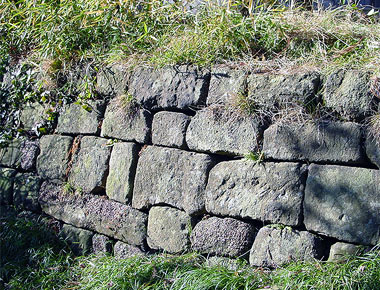|
||
 |
||
@@

@
(C)2001 Japanese Architecture and Art Net Users System.@No reproduction or republication without written permission.
fΪΜeLXgEΚ^ECXgΘΗASΔΜRecΜ³f‘»E]ΪπΦΆά·B
|
||||||
| @ | ||||||
| ishigaki@Ξ_ | ||||||
| KEY WORD :@architecture / castles | ||||||
| @ | ||||||
| A dry stone wall. A retaining stone foundation wall built without binding materials over an inclined earthen embankment. Originally intended to hold a castle embankment in place, the embankment and stone wall together were expected to provide a solid foundation for timber superstructures. When gates, towers and walls came to be built on the embankment, the ishigaki took on a multitude of functions, forming the base and sides of the gates and towers themselves, as well as the foundations for the donjon and moat. The most frequently used stone for castle walls was andesite anzangan ΐRβ, granite kakougan ΤΌβ, quartz porphyry sekieihangan ΞpΑβAand gneiss henmagan Πβ. Andesite and granite are easy stones to work, and were widely used in Edo period castles. The best stones for castle walls are considered to be shaped like a short square pillar, roughly two to three times as high as their base length. This type of stone is known as hikae T¦. The length of a stone is called *ishi-no-hikae ΞΜT¦, and the width of the rock face visible on the wall surface is called ishizura ΞΚ or tsura Κ. A distinction is made between corner stones *sumi-ishi χΞ and those not at corners *hira-ishi ½Ξ. The stones are often named according to their shapes or the way they have been cut. For example a stone narrowing at one end is called kenchi-ishi ΤmΞ, a cobble stone *tama-ishi ΚΞ, a chestnut stone used to fill small gaps *kuri-ishi IΞ, hewn stone kiri-ishi ΨΞ, and rough stone *no-ishi μΞ. There are a variety of building styles depending on the degree to which the stones are cut and prepared. Some of these styles, in order from the least worked to the most worked stones, are random masonry *ransekizumi ΞΟ, burdock masonry *gobouzumi δξΟ, natural face masonry *nozurazumi μΚΟ, pounded and inserted masonry *uchikomihagi Ε¬, cloth construction *nunozuki zz, cut inserted masonry *kirikomihagi Ψ¬ and tortoise shell stack *kikkouzumi TbΟ. Another method of construction, sangizumi ZΨΟ, uses wooden logs to stabilize the stones. Generally the surface stones of the wall are laid over a base of progressively smaller stones, pebbles, sand and earth to provide greater stability. In wet areas, the foot of the wall rests on a base supported by wooden stanchions to prevent collapse. The angle of the wall's incline varies with the height of the wall: the greater the height, the less steep the incline. According to Ogyuu Sorai's ¬Άhq (1666-1728) KENROKU ϋΒ^ (1727), there are three main shapes of castle wall: 1 walls of 45 degree elevation, called narashi Θη΅, in which only the topmost stone is completely vertical; 2 walls with a 50 degree elevation and the top 20% vertical; and 3 walls with an incline of about 80 degrees. The wall slopes upwards in a concave curve, with the top 25% completely vertical. Type two are usually pounded and inserted walls uchikomihagi, while type three are cut and inserted masonry kirikomihagi. The slope of a stone wall is called ishigaki-no-koubai Ξ_Μωz or ishigaki koubai Ξ_ωzAand the joints between the stones are called meji Ϊn. @@ |
||||||
| @ | ||||||
 |
||||||
@ |
||||||
| REFERENCES: | ||||||
| *ougi-no-koubai ξΜωz, *terakoubai ωz | ||||||
| EXTERNAL LINKS: | ||||||
| @@ | ||||||
| NOTES: | ||||||
| @ | ||||||
(C)2001 Japanese Architecture and Art Net Users System.@No reproduction or republication without written permission. fΪΜeLXgEΚ^ECXgΘΗASΔΜRecΜ³f‘»E]ΪπΦΆά·B |
||||||
| @ |